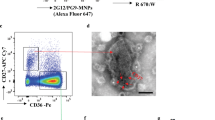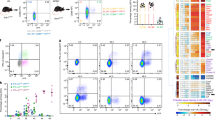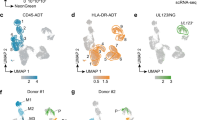Abstract
The challenge in observing de novo virus production in human immunodeficiency virus (HIV)-infected dendritic cells (DCs) is the lack of resolution between cytosolic immature and endocytic mature HIV gag protein. To track HIV production, we developed an infectious HIV construct bearing a diothiol-resistant tetracysteine motif (dTCM) at the C terminus of HIV p17 matrix within the HIV gag protein. Using this construct in combination with biarsenical dyes, we observed restricted staining of the dTCM to de novo–synthesized uncleaved gag in the DC cytosol. Co-staining with HIV gag antibodies, reactive to either p17 matrix or p24 capsid, preferentially stained mature virions and thus allowed us to track the virus at distinct stages of its life cycle within DCs and upon transfer to neighboring DCs or T cells. Thus, in staining HIV gag with biarsenical dye system in situ, we characterized a replication-competent virus capable of being tracked preferentially within infected leukocytes and observed in detail the dynamic nature of the HIV production and transfer in primary DCs.
This is a preview of subscription content, access via your institution
Access options
Subscribe to this journal
Receive 12 print issues and online access
$259.00 per year
only $21.58 per issue
Buy this article
- Purchase on Springer Link
- Instant access to full article PDF
Prices may be subject to local taxes which are calculated during checkout








Similar content being viewed by others
References
Kawamura, T. et al. Candidate microbicides block HIV-1 infection of human immature Langerhans cells within epithelial tissue explants. J. Exp. Med. 192, 1491–1500 (2000).
Lore, K., Smed-Sorensen, A., Vasudevan, J., Mascola, J.R. & Koup, R.A. Myeloid and plasmacytoid dendritic cells transfer HIV-1 preferentially to antigen-specific CD4+ T cells. J. Exp. Med. 201, 2023–2033 (2005).
Granelli-Piperno, A., Golebiowska, A., Trumpfheller, C., Siegal, F.P. & Steinman, R.M. HIV-1-infected monocyte-derived dendritic cells do not undergo maturation but can elicit IL-10 production and T cell regulation. Proc. Natl. Acad. Sci. USA 101, 7669–7674 (2004).
Moris, A. et al. DC-SIGN promotes exogenous MHC-I-restricted HIV-1 antigen presentation. Blood 103, 2648–2654 (2004).
Buseyne, F. et al. MHC-I-restricted presentation of HIV-1 virion antigens without viral replication. Nat. Med. 7, 344–349 (2001).
Rappersberger, K. et al. Langerhans' cells are an actual site of HIV-1 replication. Intervirology 29, 185–194 (1988).
Patterson, S. & Knight, S.C. Susceptibility of human peripheral blood dendritic cells to infection by human immunodeficiency virus. J. Gen. Virol. 68, 1177–1181 (1987).
Blom, J., Nielsen, C. & Rhodes, J.M. An ultrastructural study of HIV-infected human dendritic cells and monocytes/macrophages. APMIS 101, 672–680 (1993).
Hladik, F. et al. Dendritic cell-T-cell interactions support coreceptor-independent human immunodeficiency virus type 1 transmission in the human genital tract. J. Virol. 73, 5833–5842 (1999).
Raposo, G. et al. Human macrophages accumulate HIV-1 particles in MHC II compartments. Traffic 3, 718–729 (2002).
Pelchen-Matthews, A., Kramer, B. & Marsh, M. Infectious HIV-1 assembles in late endosomes in primary macrophages. J. Cell Biol. 162, 443–455 (2003).
Welsch, S. et al. HIV-1 Buds Predominantly at the Plasma Membrane of Primary Human Macrophages. PLoS Pathog. 3, e36 (2007).
Jouvenet, N. et al. Plasma membrane is the site of productive HIV-1 particle assembly. PLoS Biol. 4, e435 (2006).
Deneka, M., Pelchen-Matthews, A., Byland, R., Ruiz-Mateos, E. & Marsh, M. In macrophages, HIV-1 assembles into an intracellular plasma membrane domain containing the tetraspanins CD81, CD9, and CD53. J. Cell Biol. 177, 329–341 (2007).
Shin, N.H., Hartigan-O'Connor, D., Pfeiffer, J.K. & Telesnitsky, A. Replication of lengthened Moloney murine leukemia virus genomes is impaired at multiple stages. J. Virol. 74, 2694–2702 (2000).
Rhodes, T.D., Nikolaitchik, O., Chen, J., Powell, D. & Hu, W.S. Genetic recombination of human immunodeficiency virus type 1 in one round of viral replication: effects of genetic distance, target cells, accessory genes, and lack of high negative interference in crossover events. J. Virol. 79, 1666–1677 (2005).
Jamieson, B.D. & Zack, J.A. In vivo pathogenesis of a human immunodeficiency virus type 1 reporter virus. J. Virol. 72, 6520–6526 (1998).
Page, K.A., Liegler, T. & Feinberg, M.B. Use of a green fluorescent protein as a marker for human immunodeficiency virus type 1 infection. AIDS Res. Hum. Retroviruses 13, 1077–1081 (1997).
Petit, C. et al. Nef is required for efficient HIV-1 replication in cocultures of dendritic cells and lymphocytes. Virology 286, 225–236 (2001).
Heinzinger, N.K. et al. The Vpr protein of human immunodeficiency virus type 1 influences nuclear localization of viral nucleic acids in nondividing host cells. Proc. Natl. Acad. Sci. USA 91, 7311–7315 (1994).
Neil, S.J., Eastman, S.W., Jouvenet, N. & Bieniasz, P.D. HIV-1 Vpu promotes release and prevents endocytosis of nascent retrovirus particles from the plasma membrane. PLoS Pathog. 2, e39 (2006).
Griffin, B.A., Adams, S.R. & Tsien, R.Y. Specific covalent labeling of recombinant protein molecules inside live cells. Science 281, 269–272 (1998).
Gaietta, G. et al. Multicolor and electron microscopic imaging of connexin trafficking. Science 296, 503–507 (2002).
Martin, B.R., Giepmans, B.N., Adams, S.R. & Tsien, R.Y. Mammalian cell-based optimization of the biarsenical-binding tetracysteine motif for improved fluorescence and affinity. Nat. Biotechnol. 23, 1308–1314 (2005).
Rudner, L. et al. Dynamic fluorescent imaging of human immunodeficiency virus type 1 gag in live cells by biarsenical labeling. J. Virol. 79, 4055–4065 (2005).
Muller, B. et al. Construction and characterization of a fluorescently labeled infectious human immunodeficiency virus type 1 derivative. J. Virol. 78, 10803–10813 (2004).
Davis, D.A. et al. Conserved cysteines of the human immunodeficiency virus type 1 protease are involved in regulation of polyprotein processing and viral maturation of immature virions. J. Virol. 73, 1156–1164 (1999).
Adams, S.R. et al. New biarsenical ligands and tetracysteine motifs for protein labeling in vitro and in vivo: synthesis and biological applications. J. Am. Chem. Soc. 124, 6063–6076 (2002).
McDonald, D. et al. Visualization of the intracellular behavior of HIV in living cells. J. Cell Biol. 159, 441–452 (2002).
Ono, A., Waheed, A.A., Joshi, A. & Freed, E.O. Association of human immunodeficiency virus type 1 gag with membrane does not require highly basic sequences in the nucleocapsid: use of a novel Gag multimerization assay. J. Virol. 79, 14131–14140 (2005).
Frank, I. et al. Infectious and whole inactivated simian immunodeficiency viruses interact similarly with primate dendritic cells (DCs): differential intracellular fate of virions in mature and immature DCs. J. Virol. 76, 2936–2951 (2002).
Turville, S.G. et al. Immunodeficiency virus uptake, turnover, and 2-phase transfer in human dendritic cells. Blood 103, 2170–2179 (2004).
Huang, M., Orenstein, J.M., Martin, M.A. & Freed, E.O. p6Gag is required for particle production from full-length human immunodeficiency virus type 1 molecular clones expressing protease. J. Virol. 69, 6810–6818 (1995).
Gaietta, G.M. et al. Golgi twins in late mitosis revealed by genetically encoded tags for live cell imaging and correlated electron microscopy. Proc. Natl. Acad. Sci. USA 103, 17777–17782 (2006).
Nydegger, S., Khurana, S., Krementsov, D.N., Foti, M. & Thali, M. Mapping of tetraspanin-enriched microdomains that can function as gateways for HIV-1. J. Cell Biol. 173, 795–807 (2006).
Jolly, C., Kashefi, K., Hollinshead, M. & Sattentau, Q.J. HIV-1 cell to cell transfer across an Env-induced, actin-dependent synapse. J. Exp. Med. 199, 283–293 (2004).
Pope, M., Gezelter, S., Gallo, N., Hoffman, L. & Steinman, R.M. Low levels of HIV-1 infection in cutaneous dendritic cells promote extensive viral replication upon binding to memory CD4+ T cells. J. Exp. Med. 182, 2045–2056 (1995).
Reece, J.C. et al. HIV-1 selection by epidermal dendritic cells during transmission across human skin. J. Exp. Med. 187, 1623–1631 (1998).
Turville, S.G., Vermeire, K., Balzarini, J. & Schols, D. Sugar-binding proteins potently inhibit dendritic cell human immunodeficiency virus type 1 (HIV-1) infection and dendritic-cell-directed HIV-1 transfer. J. Virol. 79, 13519–13527 (2005).
Arhel, N. et al. Quantitative four-dimensional tracking of cytoplasmic and nuclear HIV-1 complexes. Nat. Methods 3, 817–824 (2006).
McDonald, D. et al. Recruitment of HIV and its receptors to dendritic cell-T cell junctions. Science 300, 1295–1297 (2003).
Leichert, L.I. & Jakob, U. Protein thiol modifications visualized in vivo. PLoS Biol. 2, e333 (2004).
Austin, C.D. et al. Oxidizing potential of endosomes and lysosomes limits intracellular cleavage of disulfide-based antibody-drug conjugates. Proc. Natl. Acad. Sci. USA 102, 17987–17992 (2005).
Lederman, M.M., Offord, R.E. & Hartley, O. Microbicides and other topical strategies to prevent vaginal transmission of HIV. Nat. Rev. Immunol. 6, 371–382 (2006).
Bartz, S.R. & Vodicka, M.A. Production of high-titer human immunodeficiency virus type 1 pseudotyped with vesicular stomatitis virus glycoprotein. Methods 12, 337–342 (1997).
Acknowledgements
We acknowledge assistance from the members of the Rockefeller University's Bioimaging Facility and core director A. North, F. Brilot for help with immunofluorescence staining, bioimaging analysis and editing the manuscript, S. Trapp for assistance with protein chemistry and Luminex Analyses, and I. Frank for critical evaluation of the manuscript. We thank M. Federico (Istituto Superiore di Sanità) for the deltaenvNL43 plasmid, E. Freed (US National Institute of Allergy and Infectious Diseases) for the pEnvAD8, pEnvNL43p6L1Term and pEnvNL43p6PTAP- NL43 plasmids and T. Hope (Feinberg School of Medicine, Northwestern University) for the mrfp-VPR plasmid. The TZM-bl cell line and The pHEF-VSV-G envelope plasmid was obtained from the AIDS Reagent Program, National Institute of Allergy and Infectious Diseases). This work was outlined and supported by a CJ Martin Fellowship of the National Health and Medical Research Council of Australia (S.G.T.). Also supported by National Institute of Health grants AI040877, HD041752, AI052048, AI065413, DE015512 and AI065412. H.S. and N.R. are supported by the Tilak—The Health Company (Innsbruck, Austria).
Author information
Authors and Affiliations
Contributions
S.G.T. conceived and designed the study, acquired, analyzed and interpreted data, and wrote the manuscript; M.A. acquired and analyzed data; H.S. acquired and analyzed electron microscopy data; N.R. analyzed electron microscopy data and revised the manuscript; M.R. supervised the project and wrote the manuscript.
Corresponding author
Supplementary information
Supplementary Text and Figures
Supplementary Figures 1–4, Supplementary Tables 1–2, Supplementary Methods (PDF 3863 kb)
Rights and permissions
About this article
Cite this article
Turville, S., Aravantinou, M., Stössel, H. et al. Resolution of de novo HIV production and trafficking in immature dendritic cells. Nat Methods 5, 75–85 (2008). https://doi.org/10.1038/nmeth1137
Received:
Accepted:
Published:
Issue Date:
DOI: https://doi.org/10.1038/nmeth1137
This article is cited by
-
Insights into HIV uncoating from single-particle imaging techniques
Biophysical Reviews (2022)
-
Novel RNA Duplex Locks HIV-1 in a Latent State via Chromatin-mediated Transcriptional Silencing
Molecular Therapy - Nucleic Acids (2015)
-
The infectious synapse formed between mature dendritic cells and CD4+T cells is independent of the presence of the HIV-1 envelope glycoprotein
Retrovirology (2013)
-
Revising the Role of Myeloid cells in HIV Pathogenesis
Current HIV/AIDS Reports (2013)
-
Early Events of HIV-1 Infection: Can Signaling be the Next Therapeutic Target?
Journal of Neuroimmune Pharmacology (2011)



